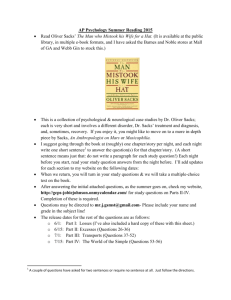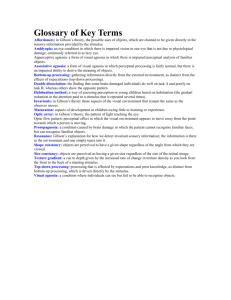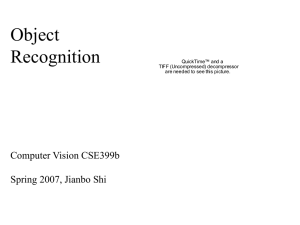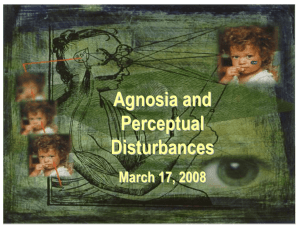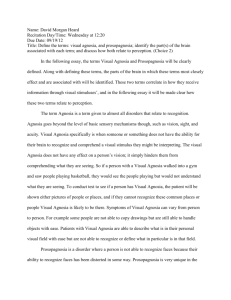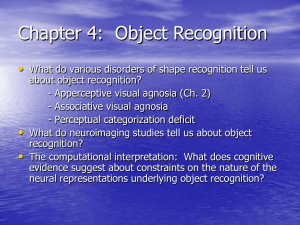Behavioral Neurology
advertisement
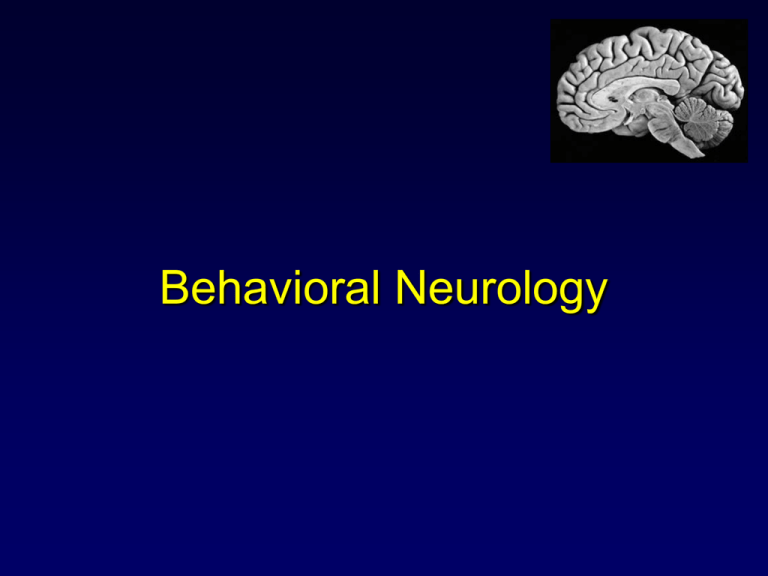
Behavioral Neurology Behavioral Neurology (Cognitive and Behavioral Neurology) - is dealing with disorders of higher nervous functions resulting from structural brain damage (directed attention, mood, gnostic functions, cognitive functions, memory, …) - investigates a relationship between brain and behavior, between brain and mind - relatively young, interdisciplinary field of study – neurology, psychiatry, neuropsychology - in the past BN dealt mainly with dementias and aphasias, currently BN is rather focused on frontal and temporal lobe syndromes, consciousness (awareness) and attention, agnosias, and many other aspects of HNF. Phineas Gage • 1848, New England • PG, 25 years, efficient and faithful foreman on the railroad construction through Vermont. • When preparing the rock shooting PG mistakenly ram down powder and detonator with iron rod (needful sand was missing). • During the explosion the iron rod (length 1 m, diameter 4 cm, 6 kg) threw open Gage’s left cheek, bashed in the base skull, passed over the ventral part of the brain and catapulted through crown of the head. • Personality change: „he started to be volatile, impolite, time to time he was extremely foul-mouthed and stubborn“. For incredibility he lost a good job, rotated with many work places (incl. career in circus), he became an alcoholic and desperate. The neurological status was otherwise normal. • He died in 38 years because of status epilepticus. H. Damasio, 1992 Patient H.M. • • • Intractable temporal lobe epilepsy from the age of 16 yrs 1953 – W. Scoville – bilateral resection of mesiotemporal regions. Postoperatively persisted serious anterograde amnesia (impairment of storage) Examination of mental functions • It should be a requisite part of standard neurologic examination – at least Mini Mental State Examination should be performed in neurologic pts. • It has to be systematic and hierarchic (level of consciousness directed attention cognition, mood, speech) • Golden neurologic rule „to localize a lesion“ should be applied for mental functions too (neuronal networks). • Extremely important is thorough history taking (changes in pt’s behavior) and focusing on the pt’s behavior during the examination (evaluation of his/her appearance, cooperation, attention, memory, mental flexibility, social adaptability, ability of nonverbal communication, depressive symptomatology, etc.). Bedside tests of attention • Luria (fist-palm-side) test • Luria sketch (visual completion test) (alternating square and pointed figs.) • Continuous performance test After registering target digit in presented digit chain a subject has to knock on a table 4-9-1-7-5-4-0-7-9-2-4-3-7-5-0-2 • Digit span test (3-7) – subject has to learn and repeat long digit chains, also test on short-term memory Large-scale neural network for directed attention (Mesulam MM) Neglect syndrome = a failure to report, respond, or orient to contralateral novel stimuli that is caused by damage of large-scale neural network for directed attention and not by an elemental sensorimotor deficit. It is a form of selective unawareness. Pts with neglect syndrome often appears to be unaware of contralateral stimuli, they ignore these items, and do not react to them. Within neglect there can be hemiakinesia (motor neglect = movement deficiency = pseudohemiparesis), anosognosia and/or anosodiaforia (absence of concomitant emotions for serious functional deficit). Bedside memory testing is limited episodic m. (autobiographic data) (mesiotemporal regions – hipp,entorh, perirh, GP) long-term m. (> 1 min) Explicite memory (declarative) semantic m. (encyclopedic knowledge) (more extensive reg. – MT+LT,P,O) F (visual x verbal, recall x recognition) short-term (working) m. (30-40 s) (digit span) (DLPFC + associative visual and auditory areas) procedural m. (completing word fragment, m. for movements) Implicit memory (subcortical circuits – BG, cerebellum + ctx visual, motor,..) demonstrated by completion priming of tasks that do not require conscious processing = the ability to acquire a motor skills or cognitive routines by experience HOSP---- Disorders of symbolic functions Dysphasia - disorders of speech (Motor or expressive /Broca΄s/ dysphasia; Sensory or receptive /Wernicke΄s/ dysphasia; Global dysphasia). DOMINANT HEMISPHERE Aprosodia – impairment of affective component of speech (speech melody, intonation, voice timbre, use of pauses, etc.) řečově nedominantní hemisféra). NON-DOMINANT HEMISPHERE Dressing apraxia - difficulties in dressing, e.g. Getting arm into pyjamas, … Constructional apraxia – innability to copy geometrical pattern Alexia - disturbance of reading (angular or lingual g. within dominant hemisphere). Agraphia - disturbance of writing (GFM or PO junction of the dominant hemisphere). Acalculia - disturbance of calculation (dominant hemisphere, also within the Gerstmann΄s syndrome – angular g.). Gnosis – greek „cognition“ • Gnostic function = an ability to know (recognize) individual objects _________________________________________________________________ AGNOSIA (without recognition) – def. = impaired recognition of an object which is sensorially presented while at the same time the impairment cannot be reduced to sensory defects (intact primary sensory cortex), mental deterioration, disorders of consciousness and attention, or to a non-familiarity with the object. The term agnosia is from S. Freud (1891) Finkelnburg 1870 – „asymbolia“ Jackson 1876 – „imperception“ Munk 1881 – „seelenblindheit“(mind blindness) /X cortical blindness/ Affected individuals behave as seeing (…) the object for the first time in their life. Beware of erroneous diagnosis of agnosias! - darkness or very rapid object presentation - unfamiliar objects (e.g. tuning fork) - insufficient instructions - overlooking another disease (polyneuropathy, cataract, otosclerosis,…) - aphasic phenomena - apraxic phenomena Agnosias are related to the lesions within associative cortices and their very surrounding but also with disconnections (impairment of the corpus callosum or long fibers within the white matter). Unfortunately in the practice agnosias are often associated with other neurologic deficits (aphasia, apraxia, behavioral disorder)! Resulting clinical manifestation is therefore highly individual. Visual agnosia Specific impairment of recognition of visually presented objects – pt is well seeing but he/she is not able to identify these items. Clinical classification according to the character of impairment: Apperceptive visual agnosia – patient is neither able to recognize objects visually nor their form, and is not able to describe it correctly. Associative visual agnosia – patient is not able to recognize objects but he/she can describe the form or even is able to draw the object correctly. According to the type of affected stimuli: - Agnosia for objects - Agnosia for colors - Akinetopsia - Prosopagnosia - Simultanagnosia - Pure alexia - ….. - Agnosia for objects (by definition pts are not able to recognize objects when they are solely presented visually. Usually visual object agnosia was considered as the classical example of agnosias, but frankly it is very rare type of visual agnosia. The most frequently it arises from bilateral (rarely just left-sided) damage of lateral parts of occipital lobes (strokes). - Agnosia for colors (coloragnosia) – the loss of ability to recognize colors as an acquired disorder. Pt is unable to recognize colors, but he/she understands colors and is able to correctly name e.g. the color of banana, orange, etc. (lesion within left occipital lobe – prestriatal cortex – ventral visual stream). It needs to be differentiated from from inability to name colors! - Hemiagnosia for colors – the inability to recognize colors confined to one half of the visual field – maybe attention defect (similarly to “unilateral spatial agnosia“)? - Akinetopsia – selective impairment of visual perception of motion („motion blindness“), whilst there is a normal recognition of colors or object forms. Lesion within extrastriatal cortex (dorsal stream, lateral TPO region). - Prosopagnosia (not as rare as visual object agnosia) – loss of ability to recognize familiar faces. It can be highly specific (for human faces, for own face, for animal faces). Most often there is a lesion within right-sided occipitotemporal or parietooccipital cortical regions (ventral stream). Auditory agnosia Very rare, usually is resulting from the lesion within the left-sided lateral temporal neocortex. – Auditory agnosia for non-linguistic sounds (“psychic deafness“) (the inability to recognize concrete sounds as animal noises, the sound of a stream of water, of a sounding bell, of a ticking of a clock, etc.) - Phonagnosia (auditory analog of prosopagnosia) – impairment of voice recognition and discrimination; the inability to recognize familiar voice (lesion in lower and lateral parts of the right parietal lobe) and to discriminate between unfamiliar voices (impairment of the temporal lobes independently of the side). De facto 2 anatomical systems – 2 distinct clinical syndromes. - Sensory amusia – the inability to recognize music, melody or rhythms (lesion within the non-dominant hemisphere) Tactile agnosia = astereognosia A condition in which objects tactually are not recognized. The sensation had to be intact. Primary astereognosia – patient is neither able to tactually recognize objects nor their forms or materials from which they are made. Secondary astereognosia – Patient does not recognize tactually objects but he/she recognizes well the form, size or material. The most commonly lesion can be found within the parietal lobe behind the postcentral gyrus (incl. supramarginal gyrus ). The disorder can be observed in lesions within both dominant and non-dominant hemispheres. Multisensorial agnosias very rare Disorders of somatognosia - impairments of the recognition of the body scheme. - Autotopagnosia – patient does not recognize parts of his/her own body. Disorder is not related to the dominant/non-dominant hemisphere, it results from impairment of contralateral parietal lobe. - Hemisomatagnosia - Finger agnosia – difficulty in distinguishing fingers on hand (this condition can be seen in Gerstmann΄s syndrome). - Mirror asomatognosia – mirror-induced disorders of the body image. Right-sided lesions. - Agnosia of pain – pain asymbolia (Schilder-Stengel syndrome) – emotional reactions to the pain are absent in the patient. Disorder is caused by the dysfunction of parietal lobe. Anosognosia – inability tp recognise and to understand own physical disability (especially motor deficit hemiplegia) that is actually denying by the patient. Typically anosognosia can be seen in pts with left-sided hemiplegia. In fact the awareness of own deficit is lacking = disorder of focused attention! Anton’s syndrome simultaneous occurrence of cortical blindness and anosognosia (pt denies truthfull loss of vision) Neglect syndrome – unilateral spatial agnosia attentional hemideficit = selective unawareness of contralateral stimuli. Practically pts with neglect syndrome “ignore“ contralateral stimuli and do not react to them. Within neglect also there can be hemiakinesia (movement deficiency) and/or anosodiaforia (absence of concomitant emotions for serious functional deficit). – damage of large-scale cortico-subcortical neurocognitive network for directed attention (right-sided inferior parietal lobule, right-sided prefrontal and orbitofrontal cortex, right-sided thalamus and basal ganglia) Dissociations between perception and consciousness after brain damage (conscious perception and unconscious /implicit, covert/ perception) - Unconscious perception in neglect syndrome There is increasing evidence that some pts with neglect may covertly perceive the contralateral stimuli and that may at least partially react to these stimuli (Volpe et al. 1979; Berti et al. 1992; Wallace 1994) - Covert recognition of faces in prosopagnosia In some cases of prosopagnosia, there has been a dramatic dissociation between the loss of face recognition ability on the one hand, and the apparently preserved ability to recognize faces, when that is assessed indirectly – skin resistance (Bauer 1984; Bruyer 1992; DeHaan et al. 1987, 1992), ERP (Renault et al. 1989) - Implicit shape perception in apperceptive visual agnosia - Implicit object identification in associative visual agnosia (Taylor and Warrington 1971; Goodale et al. 1991; Jankowiak et al. 1992; Farah and Feinberg 1997) - Blindsight – the best known syndrome – preserved ability of some patients to respond to certain aspects of visual stimuli in the areas of their visual fields that are blind on conventional clinical testing (lesions of prim. visual cortex). (Riddoch 1917; Weiskrantz et al. 1974, 1977, 1996, 1998; Perenin 1987; Ptito et al. 1991; Stoerig and Cowey 1992; Tomaiuolo et al. 1997; Sahraie et al. 1997; Zeki and ffytche 1998) - Inverse Anton’s syndrome - pt. with spared central island of vision denies visual sensation and he/she is behaving as the blind = selective impairment of awareness for visual stimuli in complete visual field (covert vision). (Walsh and Hoyt 1969; Hartmann et al. 1991; Brázdil et al. 2000) Determination of hemispheric dominance Interview about writing, eating with spoon, throwing a ball, kicking, step; tapping – domin. hand 50/min, nondomin. hand 45/min. Left hemisphere is dominant in 95% right-handers and 60% lefthanders! Left hemisphere – dominant for speech and motor functions, reading, writing, counting, recognition of colors, verbal memory, important for linguistic thinking, ... Right hemisphere – dominant for attentional functions, prosopognosia, prosodia (affective component of speech), nonverbal communication (ability to „read from face“), visuo-spatial perception, visual and topographical memory, recognition of music, … Drug-induced mental disorders Quite frequent, especially in elderly patients (mostly they are caused by pharmacological polytherapy) Depression, delirium, psychosis, agitation, aggression • • • • • • • • • • • • • • Digitalis Corticosteroids Indomethacine Phenacetine Phenylbutazone Cimetidine Benzodiazepines Captopril Propranolol Niphedipin PNC Cephalosporines Oral contraceptives Vincristine • Carbamazepine • Phenytoine • Primidone • Topiramate • Clobazam • Phenobarbital • Levodopa • Amantadine • Anticholinergics • Thyroxine • Interferone • ….. ; score > 24 normal; < 24 suggests dementia
